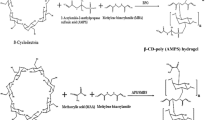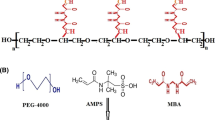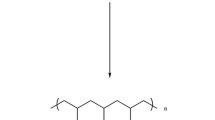Abstract
In the present work methyl methacrylate-co-itaconic acid (MMA-co-IA) hydrogels were synthesized by free radical copolymerization of methyl methacrylate (MMA) and itaconic acid (IA) using ethylene glycol dimethacrylate (EGDMA) and methylene bisacrylamide (MBAAm) as crosslinkers and benzoyl peroxide as initiator. Selected samples were loaded with model drug lactulose. For the lactulose release, the effect of pH, monomeric compositions, degree of crosslinking were investigated. The release of lactulose was studied for 8 h period in USP phosphate buffer solutions of varying pH 1.2, 5.5, 6.5 and 7.0. The drug release data were fitted into various kinetics models like the zero order, first order, Higuchi and Peppas. The release kinetics of lactulose from MMA/IA hydrogels was found to be best described by the Peppas model. Results showed that drug release increased by increasing IA content in the hydrogels but the effect of changing of crosslinking ratio on drug release was not significant. The surface morphology of MMA/IA drug loaded hydrogel was studied by SEM which revealed uniform distribution of the drug in the hydrogels. In conclusion, it can be said that lactulose can be successfully incorporated into crosslinked MMA/IA hydrogels and its release can be modulated by changing the mole fraction of the acid component in the gels.









Similar content being viewed by others
References
Kost J, Langer R (1987) Hydrogels in medicine and pharmacy, vol 3. CRC Press, Boca Raton, pp 95–108
Peppas NA (1993) Pulstile drug delively. Wissenschaftliche, Stuttgart, pp 41–56
Peppas NA (1995) Trends and future perspectives in peptide and protein delivery. Harwood, Chur, pp 23–37
García DM, Escobar JL, Noa Y, Bada N, Hernáez E, Katime I (2004) Eur Polym J 40:1683–1690
Nho YC, Park SE, Kim H, Hwang TS (2005) Nuclear Instrum Methods Phys Res Sect B 236:283–288
Serra L, Doménech J, Peppas NA (2006) Biomaterials 27:5440–5451
Sousa RG, Prior-Cabanillas A, Quijada-Garrido I, Barrales-Rienda JM (2005) J Control Rel 102:595–606
Cai H, Zhang ZP, Sun PC, He BL, Zhu XX (2005) Radiat Phys Chem 74:26–30
Chen KS, Yuan YAK, Lin HR, Yan TR, Sheu DC, Chen TM, Lin FH (2005) Mater Chem Phys 91:484–489
Tasdelen B, Kayaman-Apohan N, Guven O, Baysal BM (2005) Radiat Phys Chem 73:340–345
Tasdelen B, Kayaman-Apohan N, Guven O, Baysal BM (2004) Polym Adv Technol 15:528–532
Mudassir J, Ranjha NM (2008) J Polym Res (In Press)
Wen-Fu L, Yu-Hung L (2001) J Appl Polym Sci 81:1360–1371
Yihua Y, Yajiang Y, Huibi X (2002) J Appl Polym Sci 83:2835–2842
Ranjha NM (1999a) Saudi Pharm J 7:130–136
Ranjha NM, Doelker E (1999b) Saudi Pharm J 7:137–143
Ranjha NM, Doelker E (1999c) STP Pharma Sci 9(4):341–349
Issa K, Nora V, Jose RO (2001) Polym Int 50:869–887
M. Sen, Yakar A (2001) Int J Pharm 228:33–41
Kim SW, Bae YH, Okano T (1992) Pharm Res 9:283–290
Khan MA, Jan MR, Shah J, Iqbal Z, Khan H (2004) Am Lab 14:41–44
Okay O, Sausik SB (2000) Eur Polym J 36:393–399
Najib N, Suleiman M (1985) Drug Dev Ind Pharm 11:2169–2189
Desai SJ, Singh P, Simonelli AP, Higuchi WI (1966) J Pharm Sci 55:1230–1234
Peppas NA (1985) Pharm Acta Helv 60:110–111
Karadag E, Saraydin D (2002) Turk J Chem 26:863–875
Zhang XC, Jackson JK, Wong W, Min WX, Cruz T, Hunter WL, Burt HM (1996) Int J Pharm 137:199–208
Acknowledgements
We thank the Ministry of Health, Government of Pakistan for funding this research project. We also thank the Faculty of Pharmacy B.Z. University for providing laboratory facilities and Director, Centralized Resource Laboratory, Department of Physics University of Peshawar for providing us the facility of SEM is acknowledged.
Author information
Authors and Affiliations
Corresponding author
Rights and permissions
About this article
Cite this article
Ranjha, N.M., Mudassir, J. & Akhtar, N. Methyl methacrylate-co-itaconic acid (MMA-co-IA) hydrogels for controlled drug delivery. J Sol-Gel Sci Technol 47, 23–30 (2008). https://doi.org/10.1007/s10971-008-1750-z
Received:
Accepted:
Published:
Issue Date:
DOI: https://doi.org/10.1007/s10971-008-1750-z




